Factors Influencing the Concentration of Negative Air Ions in Urban Forests of the Zhuyu Bay Scenic Area in Yangzhou, China
Abstract
1. Introduction
2. Materials and Methods
2.1. Study Site and Plant Conditions
2.2. Measurement Methodology and Data Collection
2.3. Data Filtering
2.4. Data Processing
2.5. Establishment and Analysis of the Random Forest Model
3. Results
3.1. Seasonal Variations
3.2. Correlation Analysis
3.3. Random Forest Model
4. Discussion
5. Conclusions
Author Contributions
Funding
Institutional Review Board Statement
Informed Consent Statement
Data Availability Statement
Conflicts of Interest
References
- Miao, S.; Zhang, X.; Han, Y.; Sun, W.; Liu, C.; Yin, S. Random forest algorithm for the relationship between negative air ions and environmental factors in an urban park. Atmosphere 2018, 9, 463. [Google Scholar] [CrossRef]
- Bowers, B.; Flory, R.; Ametepe, J.; Staley, L.; Patrick, A.; Carrington, H. Controlled trial evaluation of exposure duration to negative air ions for the treatment of seasonal affective disorder. Psychiatry Res. 2018, 259, 7–14. [Google Scholar] [CrossRef]
- Zhang, Z.; Tao, S.; Zhou, B.; Zhang, X.; Zhao, Z. Plant stomatal conductance determined transpiration and photosynthesis both contribute to the enhanced negative air ion (NAI). Ecol. Indic. 2021, 130, 108114. [Google Scholar] [CrossRef]
- Jiang, S.-Y.; Ma, A.; Ramachandran, S. Negative air ions and their effects on human health and air quality improvement. Int. J. Mol. Sci. 2018, 19, 2966. [Google Scholar] [CrossRef] [PubMed]
- Zhang, J.; Yu, Z. Experimental and simulative analysis of relationship between ultraviolet irradiations and concentration of negative air ions in small chambers. J. Aerosol Sci. 2006, 37, 1347–1355. [Google Scholar] [CrossRef]
- Krueger, A.P.; Reed, E.J. Biological Impact of Small Air Ions: Despite a history of contention, there is evidence that small air ions can affect life processes. Science 1976, 193, 1209–1213. [Google Scholar] [CrossRef] [PubMed]
- Reiter, R. Part B Frequency distribution of positive and negative small ion concentrations, based on many years’ recordings at two mountain stations located at 740 and 1780 m ASL. Int. J. Biometeorol. 1985, 29, 223–231. [Google Scholar] [CrossRef]
- Deleanu, M.; Bordas, E. Morphological changes of the hypophysis-adrenal system (HAS) in albino rats with experimental gastric ulcers, under the influence of aeroionotherapy (AIT). Rom. J. Intern. Med. 1991, 29, 215–220. [Google Scholar]
- Phillips, G.; Harris, G.J.; Jones, M.W. Effect of air ions on bacterial aerosols. Int. J. Biometeorol. 1964, 8, 27–37. [Google Scholar] [CrossRef]
- Irvine, K.N.; Warber, S.L.; Devine-Wright, P.; Gaston, K.J. Understanding urban green space as a health resource: A qualitative comparison of visit motivation and derived effects among park users in Sheffield, UK. Int. J. Environ. Res. Public Health 2013, 10, 417–442. [Google Scholar] [CrossRef]
- Van Herzele, A.; De Vries, S. Linking green space to health: A comparative study of two urban neighbourhoods in Ghent, Belgium. Popul. Environ. 2012, 34, 171–193. [Google Scholar] [CrossRef]
- Watanabe, I.; Noro, H.; Ohtsuka, Y.; Mano, Y.; Agishi, Y. Physical effects of negative air ions in a wet sauna. Int. J. Biometeorol. 1997, 40, 107–112. [Google Scholar] [CrossRef]
- Ling, X.; Jayaratne, R.; Morawska, L. The relationship between airborne small ions and particles in urban environments. Atmos. Environ. 2013, 79, 1–6. [Google Scholar] [CrossRef]
- Ling, X.; Jayaratne, R.; Morawska, L. Air ion concentrations in various urban outdoor environments. Atmos. Environ. 2010, 44, 2186–2193. [Google Scholar] [CrossRef]
- Jayaratne, E.R.; J-Fatokun, F.; Morawska, L. Air ion concentrations under overhead high-voltage transmission lines. Atmos. Environ. 2008, 42, 1846–1856. [Google Scholar] [CrossRef]
- Meewes, C.; Brenneisen, P.; Wenk, J.; Kuhr, L.; Ma, W.; Alikoski, J.; Poswig, A.; Krieg, T.; Scharffetter-Kochanek, K. Adaptive antioxidant response protects dermal fibroblasts from UVA-induced phototoxicity. Free. Radic. Biol. Med. 2001, 30, 238–247. [Google Scholar] [CrossRef]
- Tikhonov, V.; Tsvetkov, V.; Litvinova, E.; Sirota, T.; Kondrashova, M. Generation of negative air ions by plants upon pulsed electrical stimulation applied to soil. Russ. J. Plant Physiol. 2004, 51, 414–419. [Google Scholar] [CrossRef]
- Skromulis, A.; Breidaks, J.; Teirumnieks, E. Effect of atmospheric pollution on air ion concentration. Energy Procedia 2017, 113, 231–237. [Google Scholar] [CrossRef]
- Zambakas, J.D. A simultaneous interpretation, by wind speed and direction, of ambient air negative ion density in Athens, Greece. Pure Appl. Geophys. 1982, 120, 691–697. [Google Scholar] [CrossRef]
- Carpenter, M. From ‘healthful exercise’to ‘nature on prescription’: The politics of urban green spaces and walking for health. Landsc. Urban Plan. 2013, 118, 120–127. [Google Scholar] [CrossRef]
- Grace, J.; Malhi, Y.; Lloyd, J.; McIntyre, J.; Miranda, A.C.; Meir, P.; Miranda, H.S. The use of eddy covariance to infer the net carbon dioxide uptake of Brazilian rain forest. Glob. Chang. Biol. 1996, 2, 209–217. [Google Scholar] [CrossRef]
- Irga, P.; Burchett, M.; Torpy, F. Does urban forestry have a quantitative effect on ambient air quality in an urban environment? Atmos. Environ. 2015, 120, 173–181. [Google Scholar] [CrossRef]
- Yang, J.; Chang, Y.; Yan, P. Ranking the suitability of common urban tree species for controlling PM2. 5 pollution. Atmos. Pollut. Res. 2015, 6, 267–277. [Google Scholar] [CrossRef]
- Mori, J.; Hanslin, H.M.; Burchi, G.; Sæbø, A. Particulate matter and element accumulation on coniferous trees at different distances from a highway. Urban For. Urban Green. 2015, 14, 170–177. [Google Scholar] [CrossRef]
- Song, Y.; Maher, B.A.; Li, F.; Wang, X.; Sun, X.; Zhang, H. Particulate matter deposited on leaf of five evergreen species in Beijing, China: Source identification and size distribution. Atmos. Environ. 2015, 105, 53–60. [Google Scholar] [CrossRef]
- Jin, S.; Guo, J.; Wheeler, S.; Kan, L.; Che, S. Evaluation of impacts of trees on PM2. 5 dispersion in urban streets. Atmos. Environ. 2014, 99, 277–287. [Google Scholar] [CrossRef]
- Wang, H.; Wang, B.; Niu, X.; Song, Q.; Li, M.; Luo, Y.; Liang, L.; Du, P.; Peng, W. Study on the change of negative air ion concentration and its influencing factors at different spatio-temporal scales. Glob. Ecol. Conserv. 2020, 23, e01008. [Google Scholar] [CrossRef]
- Jiang, S.Y.; Ma, A.; Ramachandran, S. Plant-based release system of negative air ions and its application on particulate matter removal. Indoor Air 2021, 31, 574–586. [Google Scholar] [CrossRef]
- Nadali, A.; Arfaeinia, H.; Asadgol, Z.; Fahiminia, M. Indoor and outdoor concentration of PM10, PM2. 5 and PM1 in residential building and evaluation of negative air ions (NAIs) in indoor PM removal. Environ. Pollut. Bioavailab. 2020, 32, 47–55. [Google Scholar] [CrossRef]
- Pino, O.; Ragione, F. There’s something in the air: Empirical evidence for the effects of negative air ions (NAI) on psychophysiological state and performance. Res. Psychol. Behav. Sci. 2013, 1, 48–53. [Google Scholar]
- Ubando, A.T.; Africa, A.D.M.; Maniquiz-Redillas, M.C.; Culaba, A.B.; Chen, W.-H. Reduction of particulate matter and volatile organic compounds in biorefineries: A state-of-the-art review. J. Hazard. Mater. 2021, 403, 123955. [Google Scholar] [CrossRef]
- Liu, X.; Wang, N.; Lyu, X.; Zeren, Y.; Jiang, F.; Wang, X.; Zou, S.; Ling, Z.; Guo, H. Photochemistry of ozone pollution in autumn in Pearl River Estuary, South China. Sci. Total Environ. 2021, 754, 141812. [Google Scholar] [CrossRef]
- Lam, K.-L.; Cheng, W.-Y.; Su, Y.; Li, X.; Wu, X.; Wong, K.-H.; Kwan, H.-S.; Cheung, P.C.-K. Use of random forest analysis to quantify the importance of the structural characteristics of beta-glucans for prebiotic development. Food Hydrocoll. 2020, 108, 106001. [Google Scholar] [CrossRef]
- Lozano, F.J.; Suárez-Seoane, S.; Kelly, M.; Luis, E. A multi-scale approach for modeling fire occurrence probability using satellite data and classification trees: A case study in a mountainous Mediterranean region. Remote Sens. Environ. 2008, 112, 708–719. [Google Scholar] [CrossRef]
- Amatulli, G.; Rodrigues, M.J.; Trombetti, M.; Lovreglio, R. Assessing long-term fire risk at local scale by means of decision tree technique. J. Geophys. Res. Biogeosciences 2006, 111, G04S05. [Google Scholar] [CrossRef]
- Shi, G.-Y.; Zhou, Y.; Sang, Y.-Q.; Huang, H.; Zhang, J.-S.; Meng, P.; Cai, L.-L. Modeling the response of negative air ions to environmental factors using multiple linear regression and random forest. Ecol. Inform. 2021, 66, 101464. [Google Scholar] [CrossRef]
- Li, A.; Li, Q.; Zhou, B.; Ge, X.; Cao, Y. Temporal dynamics of negative air ion concentration and its relationship with environmental factors: Results from long-term on-site monitoring. Sci. Total Environ. 2022, 832, 155057. [Google Scholar] [CrossRef]
- Zhang, K.; Wang, R.; Shen, C.; Da, L. Temporal and spatial characteristics of the urban heat island during rapid urbanization in Shanghai, China. Environ. Monit. Assess. 2010, 169, 101–112. [Google Scholar] [CrossRef] [PubMed]
- Zhao, S.; Da, L.; Tang, Z.; Fang, H.; Song, K.; Fang, J. Ecological consequences of rapid urban expansion: Shanghai, China. Front. Ecol. Environ. 2006, 4, 341–346. [Google Scholar] [CrossRef]
- Liu, X.; Guanter, L.; Liu, L.; Damm, A.; Malenovský, Z.; Rascher, U.; Peng, D.; Du, S.; Gastellu-Etchegorry, J.-P. Downscaling of solar-induced chlorophyll fluorescence from canopy level to photosystem level using a random forest model. Remote Sens. Environ. 2019, 231, 110772. [Google Scholar] [CrossRef]
- Wu, C.; Zheng, Q.; Zhong, L. A study of the aero-anion concentration in forest recreation area. Sci. Silvae Sin. 2001, 37, 75–81. [Google Scholar]
- Chen, J.; Song, Y.; Tao, K.; Ni, J. Study on the air anions of the urban greenery patches in Shanghai. Ecol. Environ. 2006, 15, 1024–1028. [Google Scholar]
- Ling, D. Review on research of the negative air ion concentration distribution and its correlation with meteorological elements in mountain tourist area. Earth Sci. 2019, 8, 60–68. [Google Scholar] [CrossRef][Green Version]
- Mu, D.; Liang, Y.-H. Air negative ion concentration and its relationships with meteorological factors in greenbelts of Jiamusi, Heilongjiang Province. Ying Yong Sheng Tai Xue Bao 2009, 20, 2038–2041. [Google Scholar]
- Zhang, Z.-P.; Yu, Y.; Zhang, M.; Du, Q.; Chen, J.; Mao, F. Negative air ion concentration and environmental factors for Mount Tianmu of Zhejiang Province. J. Zhejiang For. Coll. 2008, 25, 481–485. [Google Scholar]
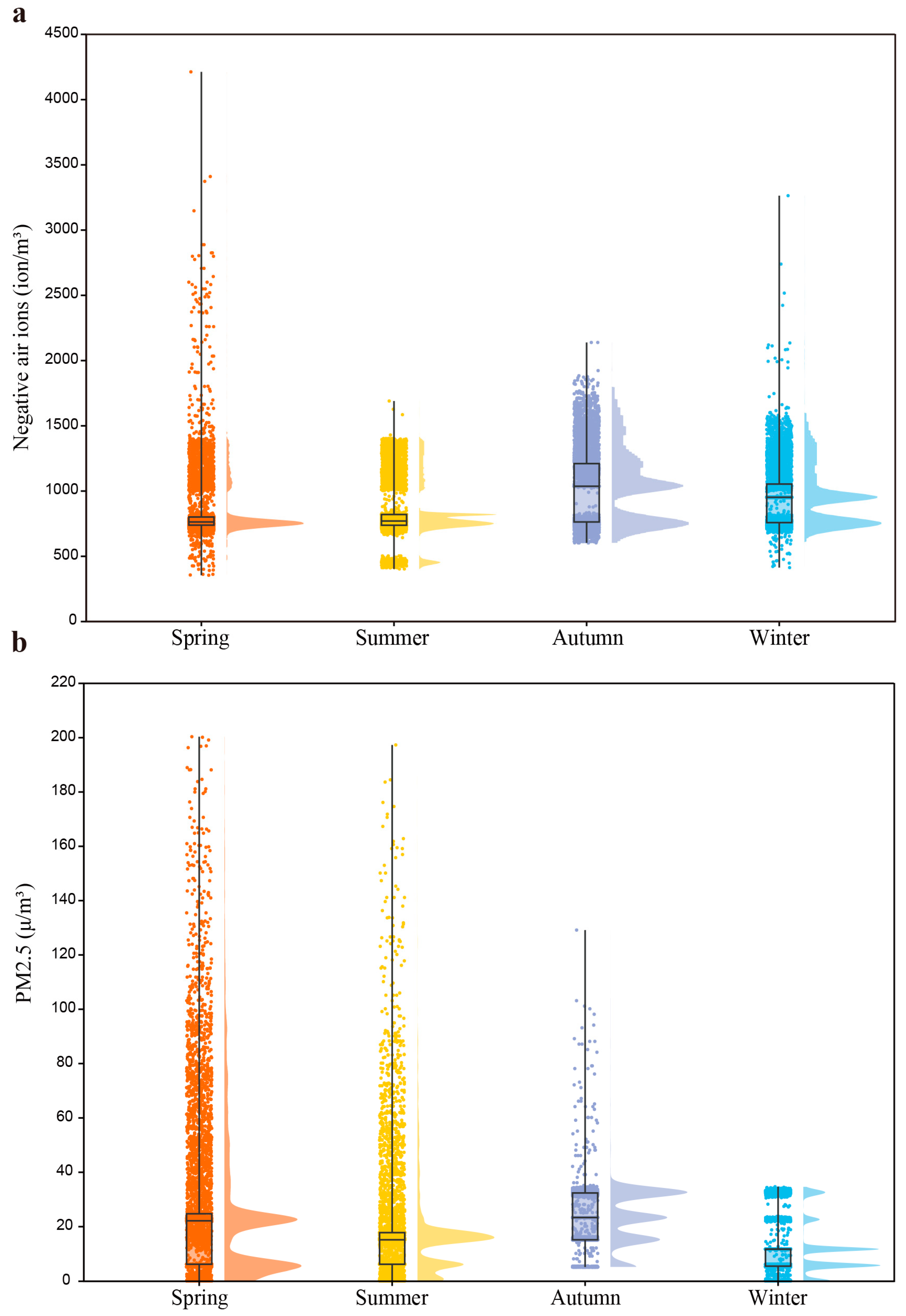
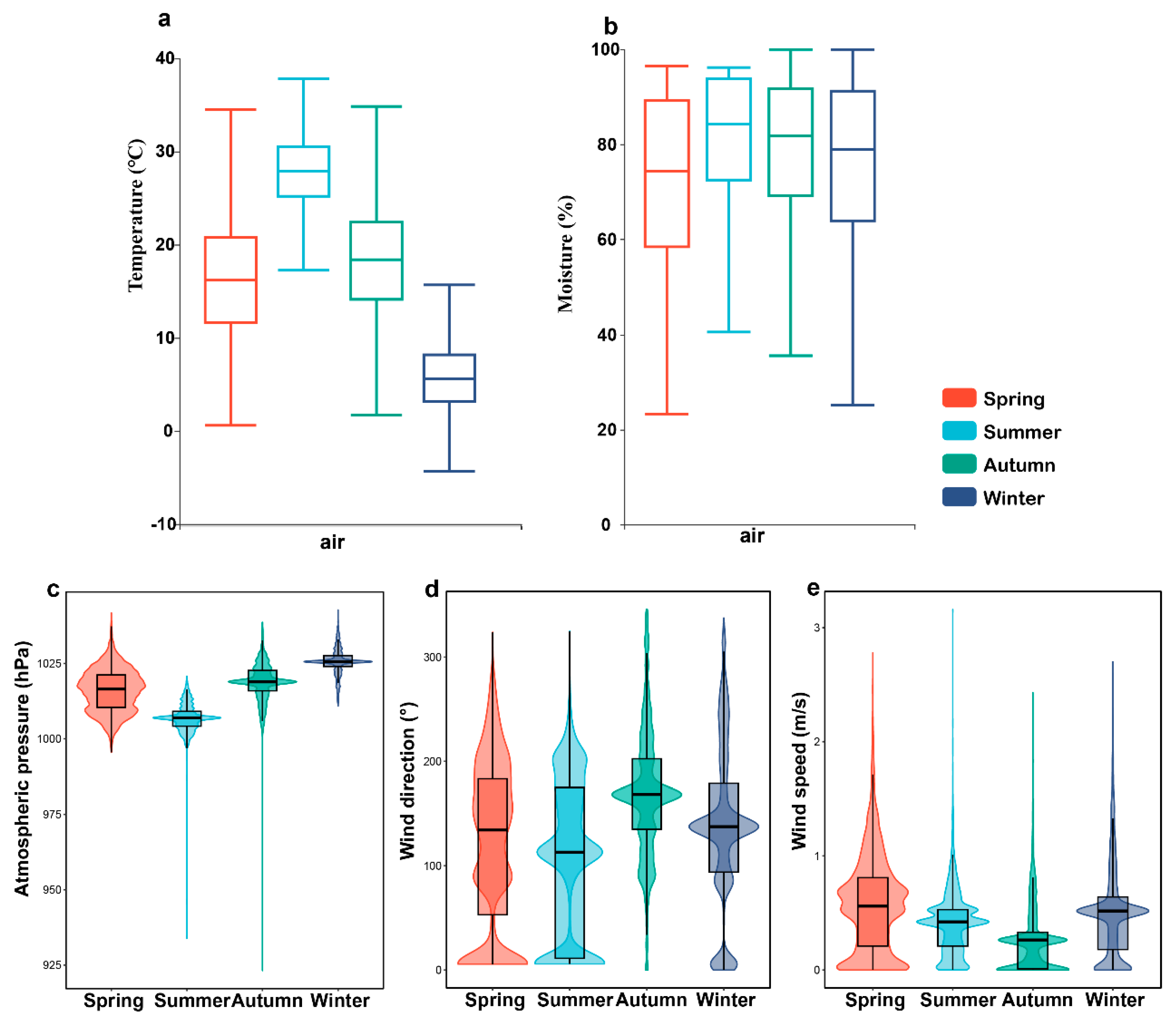
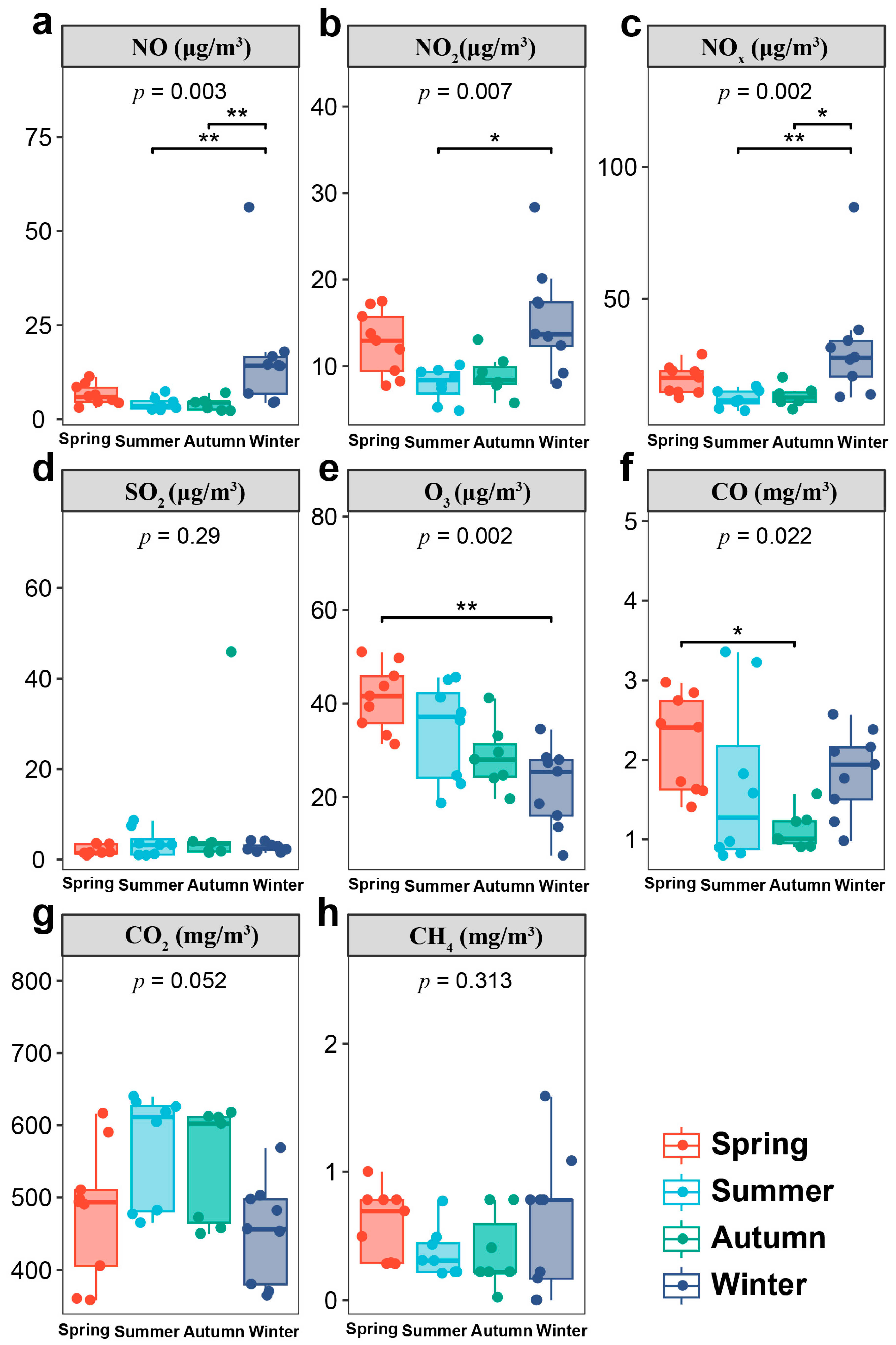
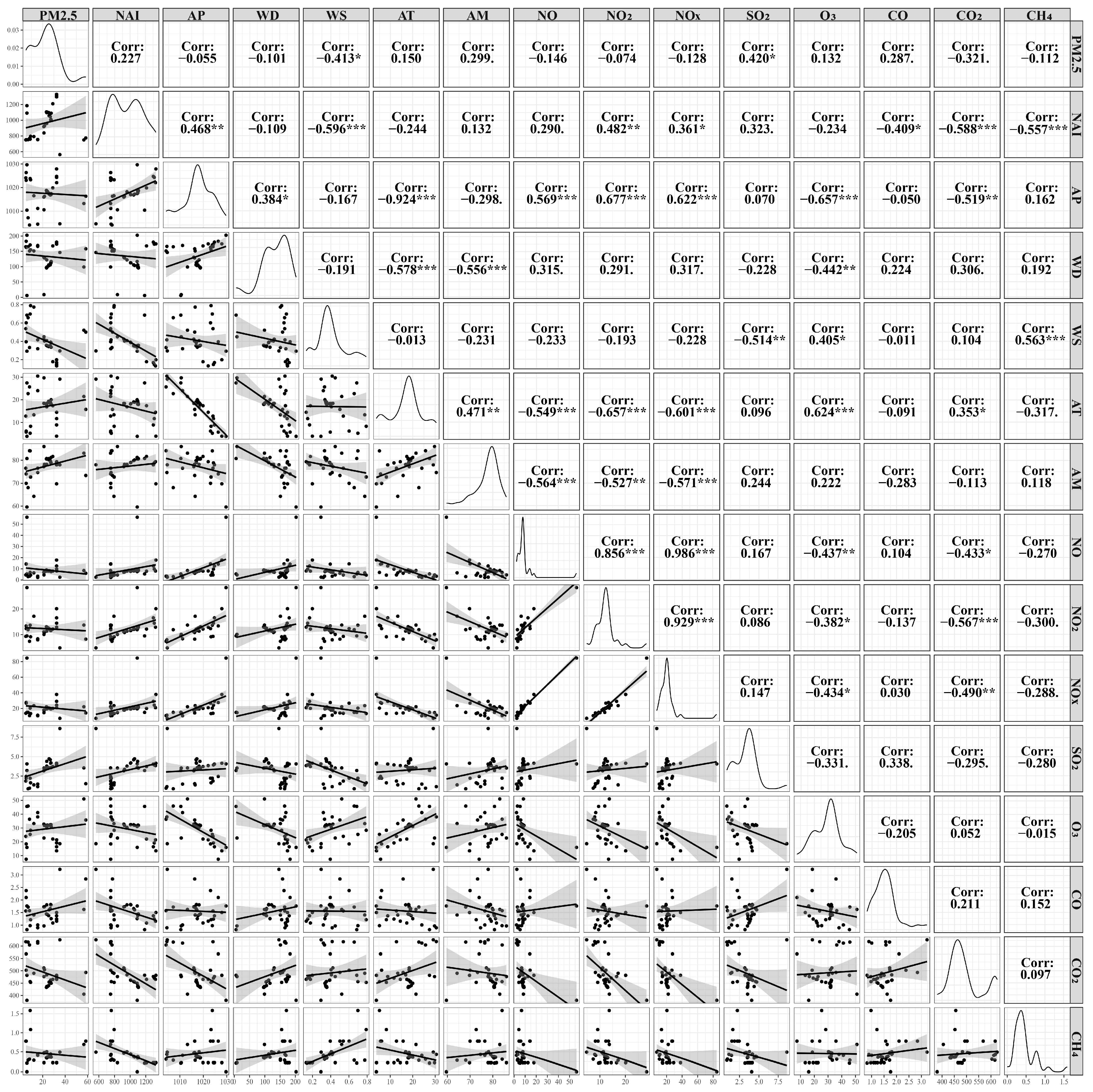
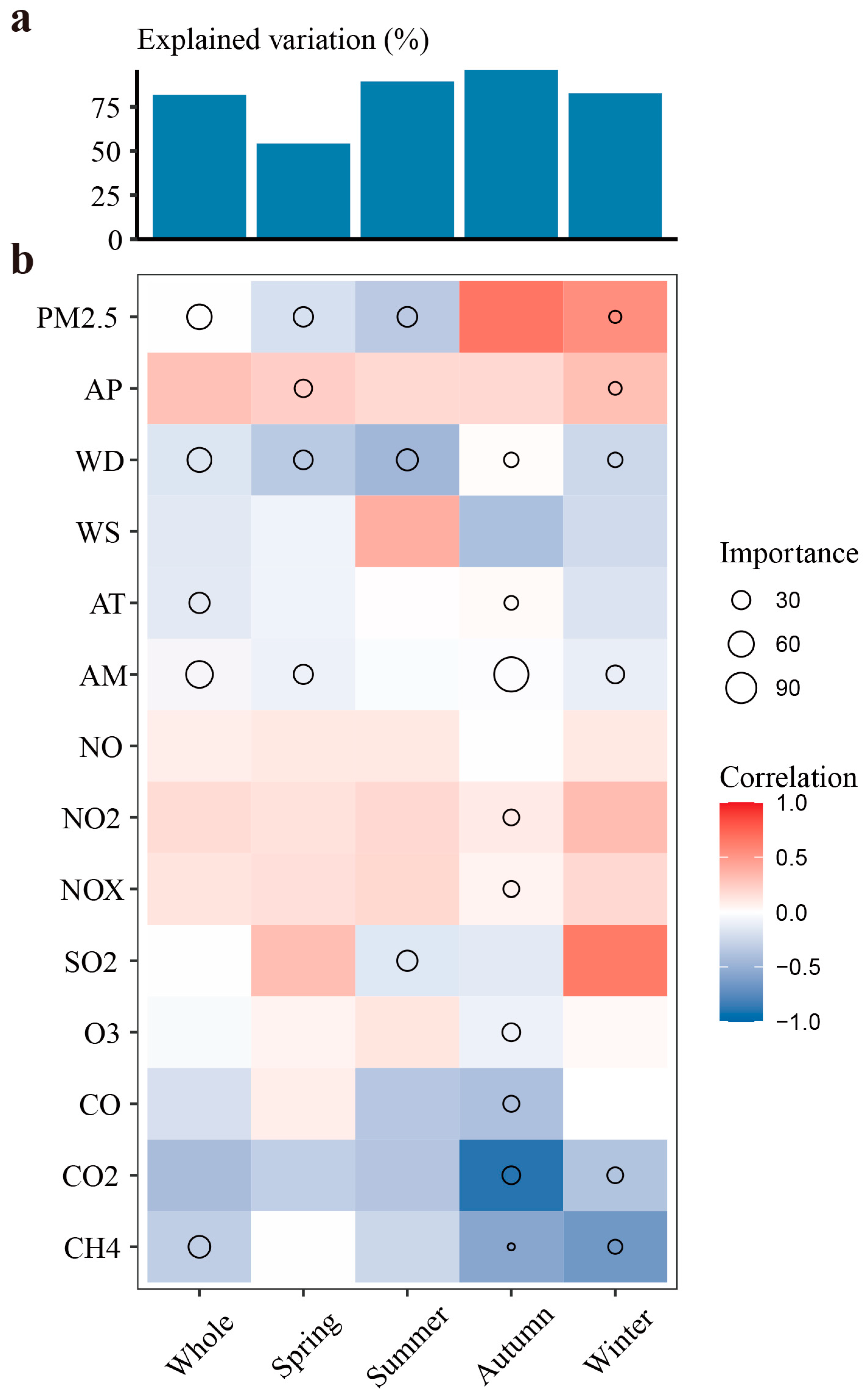
| Factors | Abbreviation | Measurement Range | Model | Brand | Origin |
|---|---|---|---|---|---|
| Particulate matter 2.5 | PM2.5 | 0~999 μg/m3 | PH-PM-999 | Puhou | Nanjing, China |
| Negative air (oxygen) ion | NAI | 0~500,000 ion/cm3 | AN-200 | Anion | Chongqing, China |
| Air pressure | AP | 300~1100 hpa | PH-APRE-101 | Puhou | Nanjing, China |
| Wind direction | WD | 0~360 | PH-WDIR-360 | Puhou | Nanjing, China |
| Wind speed | WS | 0~30 m/s | PH-WSPD-30 | Puhou | Nanjing, China |
| Air temperature | T | −20~80 °C | PH-ATERH-165 | Puhou | Nanjing, China |
| Air moisture | AM | 0~99.9% | PH-ATERH-165 | Puhou | Nanjing, China |
| Nitric oxide | NO | 0~2000 ppm | 42i | Thermo Scientific | Waltham, MA, USA |
| Nitrogen dioxide | NO2 | 0~2000 ppm | 42i | Thermo Scientific | Waltham, MA, USA |
| Oxynitride | NOX | 0~2000 ppm | 42i | Thermo Scientific | Waltham, MA, USA |
| Sulfur dioxide | SO2 | 0~2000 ppm | 43i | Thermo Scientific | Waltham, MA, USA |
| Ozone | O3 | 0~2000 ppm | 49i | Thermo Scientific | Waltham, MA, USA |
| Carbonic oxide | CO | 0~2000 ppm | 48i | Thermo Scientific | Waltham, MA, USA |
| Carbon dioxide | CO2 | 0~2000 ppm | 410i | Thermo Scientific | Waltham, MA, USA |
| Methane | CH4 | 0~2000 ppm | 5900-A | Thermo Scientific | Waltham, MA, USA |
| Factors | % IncMSE | % IncMSE p-Value |
|---|---|---|
| AM | 67.24008 | 0.00990099 |
| PM2.5 | 56.18474 | 0.00990099 |
| WD | 52.99107 | 0.00990099 |
| CH4 | 42.50171 | 0.00990099 |
| AT | 37.14405 | 0.03960396 |
| AP | 31.10199 | 0.27722772 |
| SO2 | 30.62325 | 0.34653465 |
| WS | 28.60907 | 0.71287129 |
| CO2 | 28.36984 | 0.58415842 |
| CO | 27.04638 | 0.76237624 |
| O3 | 24.49242 | 0.93069307 |
| NO2 | 18.82889 | 0.64356436 |
| NO | 14.8271 | 0.99009901 |
| NOX | 11.76385 | 0.93069307 |
Disclaimer/Publisher’s Note: The statements, opinions and data contained in all publications are solely those of the individual author(s) and contributor(s) and not of MDPI and/or the editor(s). MDPI and/or the editor(s) disclaim responsibility for any injury to people or property resulting from any ideas, methods, instructions or products referred to in the content. |
© 2024 by the authors. Licensee MDPI, Basel, Switzerland. This article is an open access article distributed under the terms and conditions of the Creative Commons Attribution (CC BY) license (https://creativecommons.org/licenses/by/4.0/).
Share and Cite
Wan, X.; Zhou, R.; Li, L.; Yang, C.; Lian, J.; Zhang, J.; Liu, S.; Xing, W.; Yuan, Y. Factors Influencing the Concentration of Negative Air Ions in Urban Forests of the Zhuyu Bay Scenic Area in Yangzhou, China. Atmosphere 2024, 15, 316. https://doi.org/10.3390/atmos15030316
Wan X, Zhou R, Li L, Yang C, Lian J, Zhang J, Liu S, Xing W, Yuan Y. Factors Influencing the Concentration of Negative Air Ions in Urban Forests of the Zhuyu Bay Scenic Area in Yangzhou, China. Atmosphere. 2024; 15(3):316. https://doi.org/10.3390/atmos15030316
Chicago/Turabian StyleWan, Xin, Runyang Zhou, Liwen Li, Can Yang, Jingwei Lian, Jiaojiao Zhang, Sian Liu, Wei Xing, and Yingdan Yuan. 2024. "Factors Influencing the Concentration of Negative Air Ions in Urban Forests of the Zhuyu Bay Scenic Area in Yangzhou, China" Atmosphere 15, no. 3: 316. https://doi.org/10.3390/atmos15030316
APA StyleWan, X., Zhou, R., Li, L., Yang, C., Lian, J., Zhang, J., Liu, S., Xing, W., & Yuan, Y. (2024). Factors Influencing the Concentration of Negative Air Ions in Urban Forests of the Zhuyu Bay Scenic Area in Yangzhou, China. Atmosphere, 15(3), 316. https://doi.org/10.3390/atmos15030316






